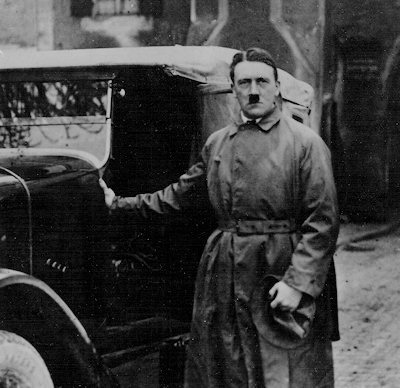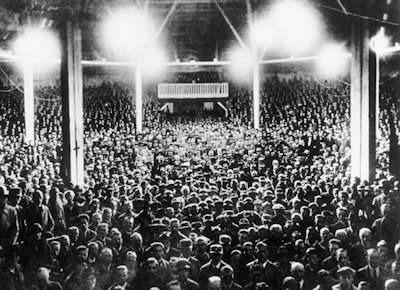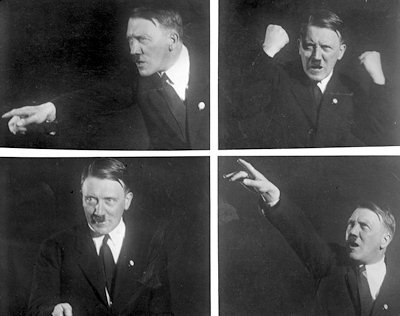![]()

A New Beginning
A few days before Christmas 1924, Adolf Hitler emerged a free man after nine months in prison, having learned from his mistakes. In addition to creating the book, Mein Kampf, Hitler had given considerable thought to the failed Nazi revolution (Beer Hall Putsch) of November 1923, and its implications for the future.
He now realized it had been premature to attempt to overthrow the democratic government by force without the support of the German Army and other established institutions. He was determined not to make that mistake again. Now, no matter how much his Nazi Party members wanted action taken against the young German democratic republic, it simply would not happen. He would not give in to them as he had done in November 1923, with disastrous, even laughable results.
Hitler had a new idea on how to topple the government and take over Germany for himself and the Nazis – play by the democratic rules and get elected.
ADVERTISEMENT "Instead of working to achieve power by an armed coup we shall have to hold our noses and enter the Reichstag against the Catholic and Marxist deputies. If outvoting them takes longer than outshooting them, at least the results will be guaranteed by their own Constitution! Any lawful process is slow. But sooner or later we shall have a majority – and after that Germany," Hitler stated while in prison.
The Nazi Party would be organized like a government itself, so that when power was achieved and democracy was legitimately ended, this 'government in waiting' could slip right into place.
But before any of this could be started, Hitler had some problems to overcome. After the Beer Hall Putsch, the government of the German state of Bavaria banned the Nazi Party and its newspaper, the Völkischer Beobachter (Peoples' Observer). Also, the Nazi Party was now badly disorganized with much infighting among its leaders.
Early in 1925, Hitler visited the Prime Minister of Bavaria and managed to convince him to lift the ban, on the promise of good behavior, and after promising that the Nazis would work within the rules of the democratic constitution. He then wrote a long editorial for the Völkischer Beobachter called "A New Beginning," published February 26, 1925.
On February 27th, the Nazis held their first big meeting since the Beer Hall Putsch at which Hitler reclaimed his position as absolute leader of the Nazi Party and patched up some of the ongoing feuds. But during his two-hour speech before four thousand cheering Nazis, Hitler got carried away and started spewing out the same old threats against the democratic republic, Marxists, and Jews.
For this, the government of Bavaria slapped him with a two-year ban on public speaking. It was a major setback for Hitler who owed much of his success to his speech making ability. But rather than be discouraged or slowed down, Hitler immediately began reorganizing the Nazi Party with feverish effort.
Below: An extraordinary photo montage created by Hitler's personal photographer reveals the well-rehearsed dramatic gestures routinely used by Hitler during his speeches to great effect. The Party itself was divided into two major political organizations.
PO I - Dedicated to undermining and overthrowing the German democratic republic.
PO II - Designed to create a government in waiting, a highly organized Nazi government within the republic that would someday replace it. PO II even had its own departments of Agriculture, Economy, Interior, Foreign Affairs, Propaganda, Justice, along with Race and Culture.
Germany was divided up by the Nazis into thirty-four districts, or Gaue, with each one having a Gauleiter, or leader. The Gau itself was divided into circles, Kreise, and each one had a Kreisleiter, or circle leader. The circles were divided into Ortsgruppen, or local groups. And in the big cities, the local groups were divided along streets and blocks.
For young people, the Hitler Jugend, or Hitler Youth was formed. It was for boys aged 15 to 18, and was modeled after the popular Boy Scout programs. Younger boys aged 10 to 15 could join the Deutsches Jungvolk. There was an organization for girls called Bund Duetscher Maedel and for women, the Frauenschaften.
Also at this time, Hitler began to reorganize his Nazi storm troopers, the SA (Sturmabteilung) which he referred to in Mein Kampf as "an instrument for the conduct and reinforcement of the movement's struggle for its philosophy of life."
The SA began as an organization of Nazi street brawlers originally called the "monitor troop" that kept Nazi meetings from being broken up by Marxists and fought with them in the streets as well. It had also been Hitler's main 'instrument' in the failed Beer Hall Putsch.
Realizing the German man's fondness for uniforms, the SA adopted a brown-shirted outfit, with boots, swastika armband, badges and cap. Nazi uniforms along with the swastika symbol would become important tools in providing recognition and visibility, thus increasing public awareness of the Party.
At this time, within the SA, a new highly disciplined guard unit was formed by Hitler that would be solely responsible to him and would serve as his personal body guard. It was called the Schutzstaffel, the staff guard or SS for short. The SS adopted a black uniform, modeled partly after the Italian Fascists. A former stationery salesman, Josef Berchtold, was its first leader. A young man who had done a variety of odd jobs for the Party became member number 168. His name was Heinrich Himmler.
But despite all this effort, the Nazis now ran into a big obstacle that limited the Party's success. Things were getting better in Germany. The economy was improving and unemployment was dropping. The big German industrialists were now debt free. Factory output was increasing as investment capital came pouring in from the United States.
An American named Charles G. Dawes had drawn up a plan, approved by the Allies, that reduced German war reparations (the amount of money Germany had to pay for damages it caused in the World War I). The Dawes Plan stabilized the German currency, the mark. The plan also provided for huge loans from America to help German industry rebuild. The German government also borrowed from the U.S. to finance its vast array of new social programs and municipal building projects including airfields, sports stadiums and even swimming pools.
And Germany now had a new president, a sleepy-eyed Old Gentleman named Paul von Hindenburg, the famed World War I Field Marshal. He was unanimously backed by the conservative and middle-of-the-road political parties to help bring stability to the republic and to thwart any attempt by radical parties to capture the presidency.
The German Army had made its peace with the young republic. Although forbidden by the Treaty of Versailles to exceed 100,000 soldiers and denied modern equipment and planes, thousands of men existed in thinly veiled paramilitary organizations funded by the Army. The German General Staff, disbanded by the treaty, simply disguised itself among its troops. The Army was also secretly engaged in developing new technologies in Russian factories and was involved in training exercises with the Russian Army.
Thus, despite appearances to the Allies, the German General Staff and its Army was allowed to achieve its primary goal, self preservation and advancement, and so it supported German democracy for the time being.
As things got better economically, there was a sense of relaxation among the German people. Since they didn't have to struggle so much for daily existence, they had time for enjoyment, outdoor recreation, the arts, and sitting around beer halls and cafés. Among these people, the name of Adolf Hitler was likely to bring a smile, perhaps getting him a bit confused with the great film comedian Charlie Chaplin who looked like him and even had some of the same body language.
Amid all this, Adolf Hitler knew it was going to be slow going for his Party which had counted so many unhappy, disgruntled men among its early members. But Hitler also had a sense that the good times would not last. The German republic was living on borrowed money and borrowed time. The underlying political and racial tensions he was so keen to exploit were still there, only dormant. And when the good times were over, they would once again come looking for him. But for now he just had to wait.
Copyright © 1996 The History Place™ All Rights Reserved
![]()
NEXT SECTION - The Quiet Years
The Rise of Hitler Index
The History Place Main Page
Terms of use: Private home/school non-commercial, non-Internet re-usage only is allowed of any text, graphics, photos, audio clips, other electronic files or materials from The History Place.


